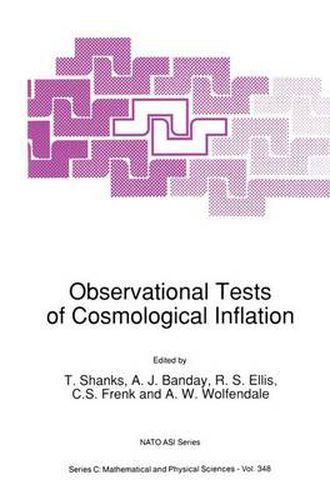Readings Newsletter
Become a Readings Member to make your shopping experience even easier.
Sign in or sign up for free!
You’re not far away from qualifying for FREE standard shipping within Australia
You’ve qualified for FREE standard shipping within Australia
The cart is loading…






This title is printed to order. This book may have been self-published. If so, we cannot guarantee the quality of the content. In the main most books will have gone through the editing process however some may not. We therefore suggest that you be aware of this before ordering this book. If in doubt check either the author or publisher’s details as we are unable to accept any returns unless they are faulty. Please contact us if you have any questions.
This book represents the proceedings from the NATO sponsored Advanced Research Workshop entitled Observational Tests of Inflation held at the University of Durham, England on the 10th-14th December, 1990. In recent years, the cosmological inflation model has drawn together the worlds of particle physics, theoretical cosmology and observational astronomy. The aim of the workshop was to bring together experts in all of these fields to discuss the current status of the inflation theory and its observational predictions. The simplest inflation model makes clear predictions which are testable by astronomical observation. Foremost is the prediction that the cosmological density parameter, no, should have a value negligibly different from the critical, Einstein-de Sitter value of 00=1. The other main prediction is that the spectrum of primordial density fluctuations should be Gaussian and take the Harrison-Zeldovich form. The prediction that n =l, in patticular, leads to several important consequences o for cosmology. Firstly, there is the apparent contradiction with the limits on baryon density from Big Bang nucleosynthesis which has led to the common conjecture that weakly interacting particles rather than baryons may form the dominant mass constituent of the Universe. Secondly, with n =l, the age of the Universe is uncomfortably short if o the Hubble constant and the ages of the oldest star clusters lie within their currently believed limits.
$9.00 standard shipping within Australia
FREE standard shipping within Australia for orders over $100.00
Express & International shipping calculated at checkout
This title is printed to order. This book may have been self-published. If so, we cannot guarantee the quality of the content. In the main most books will have gone through the editing process however some may not. We therefore suggest that you be aware of this before ordering this book. If in doubt check either the author or publisher’s details as we are unable to accept any returns unless they are faulty. Please contact us if you have any questions.
This book represents the proceedings from the NATO sponsored Advanced Research Workshop entitled Observational Tests of Inflation held at the University of Durham, England on the 10th-14th December, 1990. In recent years, the cosmological inflation model has drawn together the worlds of particle physics, theoretical cosmology and observational astronomy. The aim of the workshop was to bring together experts in all of these fields to discuss the current status of the inflation theory and its observational predictions. The simplest inflation model makes clear predictions which are testable by astronomical observation. Foremost is the prediction that the cosmological density parameter, no, should have a value negligibly different from the critical, Einstein-de Sitter value of 00=1. The other main prediction is that the spectrum of primordial density fluctuations should be Gaussian and take the Harrison-Zeldovich form. The prediction that n =l, in patticular, leads to several important consequences o for cosmology. Firstly, there is the apparent contradiction with the limits on baryon density from Big Bang nucleosynthesis which has led to the common conjecture that weakly interacting particles rather than baryons may form the dominant mass constituent of the Universe. Secondly, with n =l, the age of the Universe is uncomfortably short if o the Hubble constant and the ages of the oldest star clusters lie within their currently believed limits.